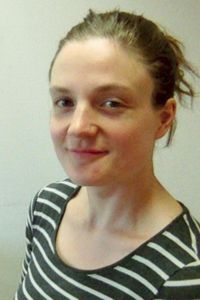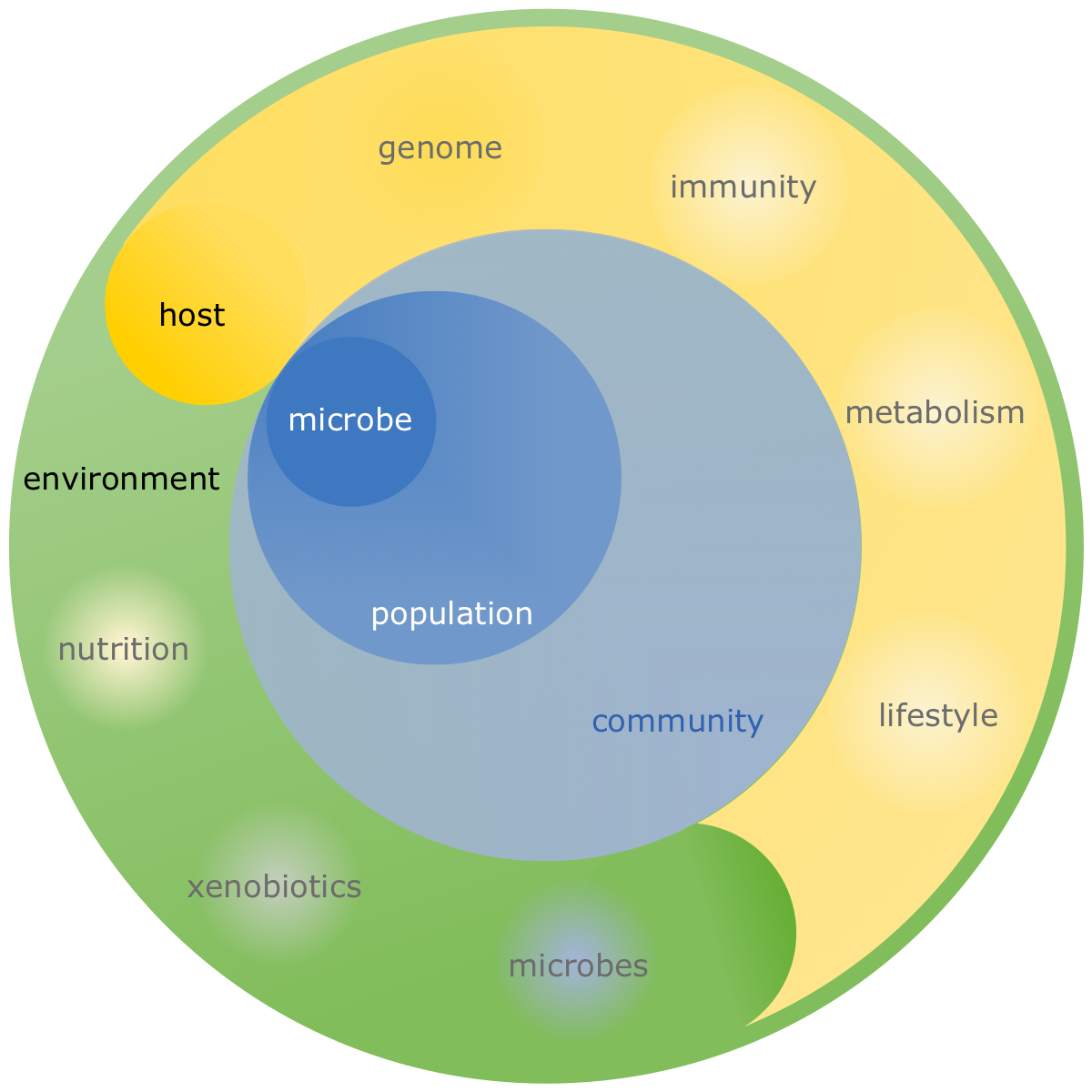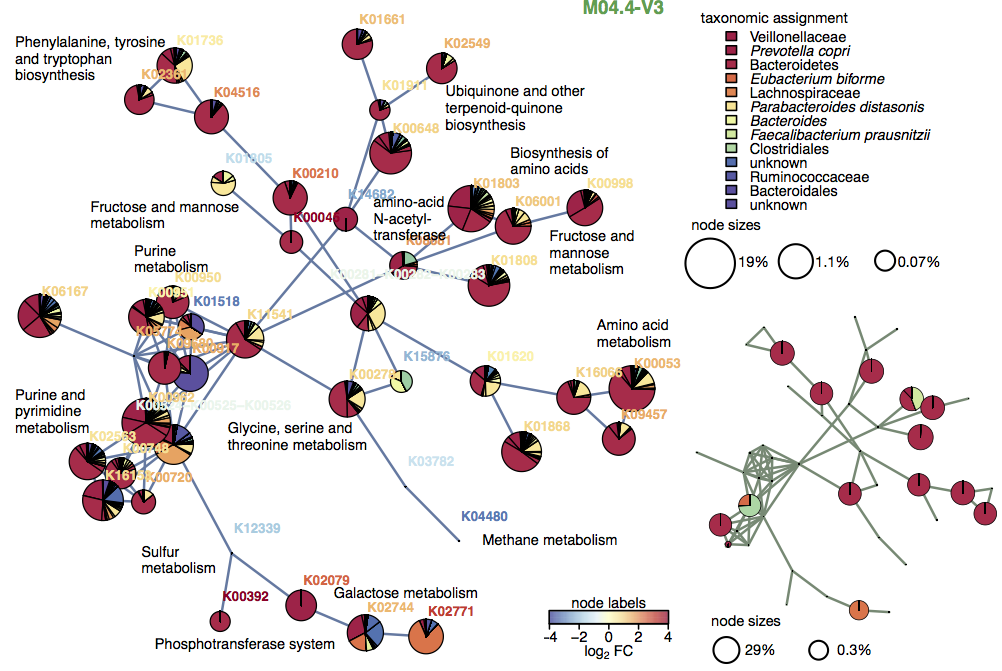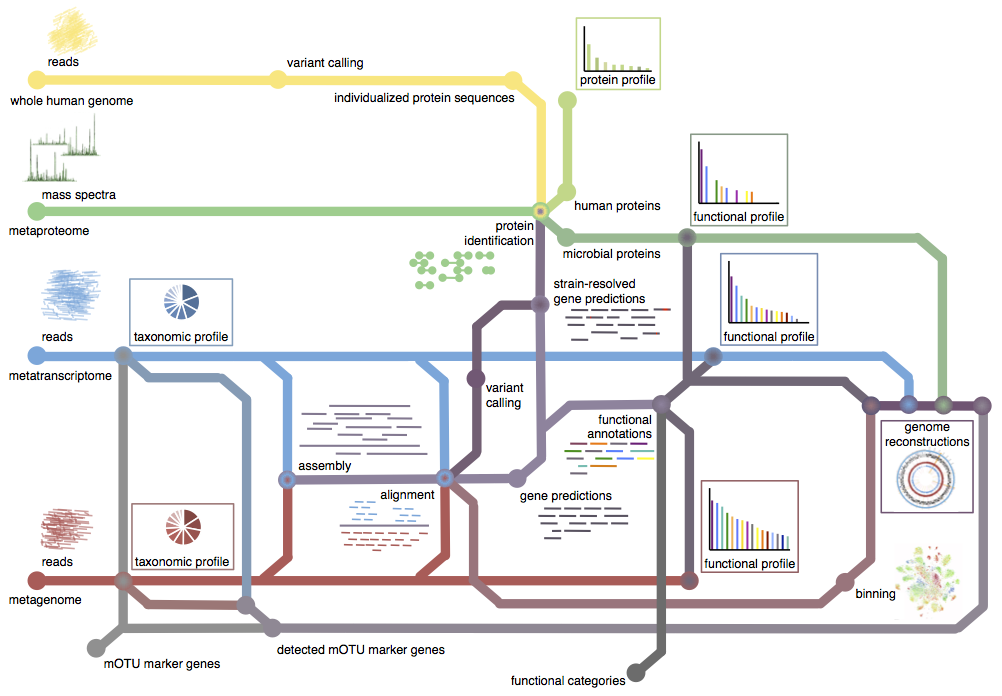Dr. Anna Heintz-Buschart
Contact / Address
Dr. Anna Heintz-Buschart
Alumna
Department of Soil Ecology
Helmholtz Centre for Environmental Research - UFZ
Theodor-Lieser-Strasse 4 | D-06120 Halle/Saale
Germany
Metagenomics Support Unit
German Centre for Integrative Biodiversity Research (iDiv) Halle-Jena-Leipzig
Email:
Twitter:


Research interests at UFZ and iDiv (2017-2021)
I have left UFZ and iDiv in July 2021. For information on metagenomics support, contact Prof Dr François Buscot .
Omics and bioinformatics methods for integrated analyses of microbial communities
 Conceptually, microbial genomes of mixed-microbial communities and gene expression are shaped by the interaction with close relatives within the same population, with other microbes, and with the environment, including multi-cellular hosts. For host-associated microbiota, the host genome, immune and defense systems, metabolism and lifestyle are important factors, which also drive the microbiota's exposure to environmental nutrients, potentially anti-microbial xenobiotics and other microbes.
Conceptually, microbial genomes of mixed-microbial communities and gene expression are shaped by the interaction with close relatives within the same population, with other microbes, and with the environment, including multi-cellular hosts. For host-associated microbiota, the host genome, immune and defense systems, metabolism and lifestyle are important factors, which also drive the microbiota's exposure to environmental nutrients, potentially anti-microbial xenobiotics and other microbes.
Microbial communities play important roles in global nutrient cycling and energy fluxes, in addition to forming close associations and directly interacting with macrobiota. These cross-kingdom interactions are fundamental to most natural and agricultural systems, as well as to human health, but we still know relatively little about the processes that lead to the assembly and maintenance of microbe-host associations.
State-of-the-art ‘omics’ technologies, such as metagenomics, metatranscriptomics, metaproteomics and metabolomics can be applied to microbial samples to answer important questions.
Which organisms are present? what is their functional potential, i.e. which genes are encoded by their genomes? which genes are expressed, collectively by a microbial community, or by which members? which metabolic enzymes, metabolites and structural proteins are present, i.e. what is the microbial activity? The answers to these questions can provide deep insights into the capabilities and interactions within a microbial community and its interaction with the environment and potential host organisms. However, all of these answers come “hidden” in large volumes of data. My interest lies in the facilitation of biological interpretations through the application and development of bioinformatics methods that are able to extract meaningful information from omics data.


Next to the processing of different omics datasets, one challenge is the integration of different omics levels. This requires suitable databases, meaningful normalization and multivariate statistics. On the other hand, synergies between multiple omic levels can be utilized, because borrowing information from one omic level can improve the detection or interpretation of entities on other omics levels. Finally, contextualization and visualization are computational tools that greatly drive biological interpretations.
Research projects at UFZ and iDiv (2017-2021)
Jena Experiment
Together with François Buscot and doctoral candidate Cynthia Albracht, I study the role of arbuscular mycorrhizal fungi in the establishment of long-term biodiversity-ecosystem functioning relationships in the grassland of the Jena experiment since 2020. In the related Flexpool project RESFun we collaborate with Prof. Alexandra Weigelt of Leipzig University and her PhD student Justus Hennecke. They are interested in the fungi attracted by plants with roots that commit to different strategies for exploiting soil resources ("root economics space").
DiscoMole and iSBio
Thanks to a DFG-grant for NGS, our iDiv consortium "Soil Biodiversity and Function" could sequence metagenomes of soil samples from the iSBio-initiative. This collection comes with a deep functional characterisation. We now want to understand the relationships between microbial diversity and soil functions for these samples, taken from a wide range of environmental gradients. As part of the iDiv Flexpool project DiscoMole, Qicheng Bei is developing scenario-based models of pathogen loads in the future.
Further collaborations:
As contact person from 2017-2021 for the omics and bioinformatics platform in the soil ecology department, I got to work with most of my colleagues at the soil ecology department and a wide range of researchers from iDiv.
The global change experimental facility (GCEF) is a field experiment to simulate consequences of climate change on ecosystem processes in different land-use types. Together with Claudia Breitkreutz, Marie-Lara Bouffaud, Mika Tarkka and Thomas Reitz, we investigated changes in microbial communities and their function. With Witoon Purahong and Sara Wahdan, we focused on decomposition processes and high-resolution analysis of the functional potential and activity of the involved microbes.
The biodiversity exploratories are a central project in our department. Julia Moll studies bacterial, archaean and fungal communities in deadwood and their interaction networks. With Kezia Goldmann we've finished a study on spatial-temporal patterns of AMF diversity in a grassland: Scalemic.
Within SPP2089 Rhizosphere Spatiotemporal Organisation, Mika Tarkka and Minh Ganther investigate spatially and temporally resolved gene expression of maize roots. In the future, they will also take into account plant-microbe interactions.
The work of François Buscots PhD students Luis Daniel Prada Salcedo and Jean de Dieu Habiyaremye on soil microbiota in the Soil for Europe project and with the PhytOakmeters of Sylvie Herrmann was supported with pipeline development.
The scientific consortium "Soil Biodiversity and Function" bundles complementary soil expertise and activities within iDiv to advance science and education in soil biodiversity.
With the iDiv Soil Biodiversity and Function consortium, in particular Nico Eisenhauer's Experimental Interaction Ecology group and Ika Djukic's TeaComposition initiative, we explore microbial communities and soil functions along environmental gradients.
Kezia Goldmann and Olga Ferlian from Nico Eisenhauer's Experimental Interaction Ecology analysed the diversity and composition of mycorrhizal fungi in the myDiv Experiment.
I collaborate with Hjalmar Kühl and others of the Max Planck Institute for Evolutionary Anthropology and Alexandra Muellner-Riehl's Molecular Evolution and Plant Systematics group at University Leipzig on the Pan-African Chimpanzee Microbiome and Diet Research Project.
With Marie Spohn's group, formerly on Soil Biogeochemistry at the University Bayreuth, we analysed effects of long-term nitrogen and phosphorus fertilization on grassland microbial communities.
Selected publications
M. Marselle, T. Hartig, D. Cox, S. de Bell, S. Knapp, S. Lindley, M. Triguero-Mas, K. Böhning-Gaese, P.A. Cook, S. de Vries, A. Heintz-Buschart, M. Hofmann, K.N. Irvine, N. Kabisch, F. Kolek, R. Kraemer, I. Markevych, D. Martens, R. Müller, M. Nieuwenhuijsen, J.M. Potts, J. Stadler, S. Walton, S.L. Warber, A. Bonn (2021): Pathways linking biodiversity to human health: a conceptual framework. Environment International, 150: 106420.
C. Weißbecker, B. Schnabel, A. Heintz-Buschart (2020): dadasnake, a Snakemake implementation of DADA2 to process amplicon sequencing data for microbial ecology. GigaScience 9: giaa135.
C.A. Guerra, A. Heintz-Buschart, J. Sikorski, A. Chatzinotas, N. Guerrero-Ramírez, S. Cesarz, L. Beaumelle, M.C. Rillig, F.T. Maestre, M. Delgado-Baquerizo, F. Buscot, J. Overmann, G. Patoine, H.R.P. Phillips, M. Winter, T. Wubet, K. Küsel, R.D. Bardgett, E.K. Cameron, D. Cowan, T. Grebenc, C. Marín, A. Orgiazzi, B.K. Singh, D.H. Wall, N. Eisenhauer (2020): Blind spots in global soil biodiversity and ecosystem function research. Nature Communications 11: 3870.
P.-M. Schleuss, M. Widdig, A. Heintz-Buschart, A. Guhr, S. Martin, K. Kirkman, M. Spohn (2019): Stoichiometric controls of soil carbon and nitrogen cycling after long-term nitrogen and phosphorus addition in a mesic grassland in South Africa. Soil Biology & Biochemistry 135: 294-303.
L. Wampach*, A. Heintz-Buschart*, J.V. Fritz*, J. Ramiro-Garcia, J. Habier, M. Herold, S. Narayanasamy, A. Kaysen, A.H. Hogan, L. Bindl, J. Bottu, R. Halder, C. Sjöqvist, P. May, A.F. Andersson, C. de Beaufort, P. Wilmes (2018): Birth mode is associated with earliest strain-conferred gut microbiome functions and immunostimulatory potential. Nature Communications 9: 5091.
A. Heintz-Buschart, P. May, C.C. Laczny, L.A. Lebrun, C. Bellora, A. Krishna, L. Wampach, J.G. Schneider, A. Hogan, C. de Beaufort, P. Wilmes (2016): Integrated multi-omics of the human gut microbiome in a case study of familial type 1 diabetes. Nat. Microbiol. 2: 16180. Erratum in Nat. Microbiol. 2: 16227.
H. Roume*, A. Heintz-Buschart*, E.E.L. Muller, P. May, V.P. Satagopam, C.C. Laczny, S. Narayanasamy, L.A. Lebrun, M.R. Hoopmann, J.M. Schupp, J.D. Gillece, N.D, Hicks, D.M. Engelthaler, T. Sauter, P.S. Keim, R.L. Moritz, P. Wilmes (2015). Comparative integrated omics: identification of key functionalities in microbial community-wide metabolic networks. NPJ Biofilms Microbiomes 1: 15007.
Code from publications
dadasnake pipeline: https://github.com/a-h-b/dadasnake
Text mining and automated access to sequencing data for Jurburg et al. (2020): https://github.com/a-h-b/pdf_to_sequence
R-script from Goldmann et al., Environmental Microbiology (2019): https://a-h-b.github.io/SCALEMIC-betaDiv/
Repository for Wampach, Heintz-Buschart and Fritz et al., Nature Communications (2018): https://git-r3lab.uni.lu/Cosmic/Earliest
Repository for Heintz-Buschart et al., BMC Biology (2018): https://git.ufz.de/metaOmics/contaminomics
Repository for Heintz-Buschart et al., Nature Microbiology (2016): https://git-r3lab.uni.lu/anna.buschart/MuStMultiomics
CV / Scientific career
Since August 2021, I am an Assistant Professor for Microbial Metagenomics at the Swammerdam Institute for Life Sciences at the University of Amsterdam.
September 2017 - July 2021
Scientist
Helmholtz Centre for Environmental Research, Halle - Department of Soil Ecology
German Centre for Integrative Biodiversity Research (iDiv) Halle-Jena-Leipzig - Metagenomics Support Unit (2017-2020 Bioinformatics Unit)
Bioinformatics and statistics for metagenomics and functional (meta-)omics:
- methods development for multi-omics of mixed microbial communities.
- integration of physiological, environmental and community census data.
- analysis of microbial community structure and function of mixed microbial communities.
2012 - 2017
Postdoc
Luxembourg Centre for Systems Biomedicine, Luxembourg - Eco-Systems Biology group
Multi-omics analyses of mixed microbial communities:
- statistical and ecological analysis of microbial community structure and function of human microbiota and activated sludge.
- bioinformatics methods development for the integration of multi-omics data from next generation sequencing and mass-spectrometry experiments.
- development and supervision of an automated robotic platform for biomolecular extraction.
2011 - 2012
Postdoc
Helmholtz Centre for Infection Research, Braunschweig - Biological Systems Analysis group
Work on the interaction of mammalian innate immune cells with Candida albicans:
- modelling and experimental validation of signal transduction and gene regulatory networks.
- analysis of transcriptome data.
2008 - 2011
Helmholtz Centre for Infection Research, Braunschweig - Biological Systems Analysis group
Thesis: "Development of screening assays and characterisation of new antifungal compounds against Candida albicans"
2002 - 2008
Diploma in Biology
University Bremen, Germany
Major in Microbiology with botany and cellular biology - thesis: "Investigation of the bacterial and plant gene expression in the interaction of Azoarcus sp. strain BH72 and rice"
List of publications until July 2021
S.F.M. Wahdan, T. Reitz, A. Heintz-Buschart, M. Schädler, C. Roscher, C. Breitkreuz, B. Schnabel, W. Purahong, F. Buscot (2021): Organic agricultural practice enhances arbuscular mycorrhizal symbiosis in correspondence to soil warming and altered precipitation patterns. Environmental Microbiology and Environmental Microbiology Reports DOI: 10.1111/1462-2920.15492
R.M. Chakaroun, L. Massier, A. Heintz-Buschart, N. Said, J. Fallmann, A. Crane, T. Schütz, A. Dietrich, M. Blüher, M. Stumvoll, N. Musat, P. Kovacs (2021): Circulating bacterial signature is linked to metabolic disease and shifts with metabolic alleviation after bariatric surgery. Genome Medicine 13: 105.
C. Bueno de Mesquita, L. Nichols, M. Gebert, C. Vanderburgh, G. Bocksberger, J. Lester, A. Kalan, P. Dieguez, M. McCarthy, A. Agbor, P. Álvarez Varona, E. Ayimisin, M. Bessone, R. Chancellor, H. Cohen, C. Coupland, T. Deschner, V. Ebot Egbe, A. Goedmakers, A.-C. Granjon, C. Grueter, J. Head, R.A. Hernandez-Aguilar, K. Jeffery, S. Jones, P. Kadam, M. Kaiser, J. Lapuente, B. Larson, S. Marrocoli, D. Morgan, B. Mugerwa, F. Mulindahabi, E. Neil, P. Niyigaba, L. Pacheco, A. Piel, M. Robbins, A. Rundus, C. Sanz, L. Sciaky, D. Sheil, V. Sommer, F. Stewart, E. Ton, J. van Schijndel, V. Vergnes, E. Wessling, R. Wittig, Y. Ginath Yuh, K. Yurkiw, K. Zuberbühler, J. Gogarten, A. Heintz-Buschart, A. Muellner-Riehl, C. Boesch, H. Kühl, N. Fierer, M. Arandjelovic, R. Dunn (2021) Structure of the chimpanzee gut microbiome across their range. mSystems 6: e01269-20.
M. Ganther, D. Vetterlein, A. Heintz-Buschart, M.T. Tarkka (2021): Transcriptome sequencing analysis of maize roots reveals the effects of substrate and root hair formation in a spatial context. Plant and Soil DOI: 10.1007/s11104-021-04921-0 .
L. de Nies, S. Lopes, A. Heintz-Buschart, C.C. Laczny, P. May, P. Wilmes (2021): PathoFact: A pipeline for the prediction of virulence factors and antimicrobial resistance genes in metagenomic data. Microbiome 9:49.
S.B. Busi, L. de Nies, J. Habier, L. Wampach, J.V. Fritz, A. Heintz-Buschart, P. May, R. Halder, C. de Beaufort, P. Wilmes (2021): Persistence of birth mode-dependent effects on gut microbiome composition, immune system stimulation and antimicrobial resistance during the first year of life. ISME Communications 1:8.
J. Moll*, A. Heintz-Buschart*, C. Bässler, M. Hofrichter, H. Kellner, F. Buscot, B. Hoppe (2021): Amplicon sequencing-based bipartite network analysis confirms a high degree of specialization and modularity for fungi and prokaryotes in deadwood. mSphere, DOI: 10.1128/mSphere.00856-20.
S.F.M. Wahdan, A. Heintz-Buschart, C. Sansupa, B. Tanunchai, Y.-T. Wu, M. Schädler, M. Noll, W. Purahong, F. Buscot (2021). Targeting the active rhizosphere microbiome of Trifolium pratense in grassland evidences a stronger-than-expected belowground biodiversity-ecosystem functioning link. Frontiers in Microbiology 12: 73.
L. Gebauer, M.-L. Bouffaud, M. Ganther, B. Yim, D. Vetterlein, K. Smalla, F. Buscot, A. Heintz-Buschart, M.T. Tarkka (2021). Soil texture, sampling depth and root hairs shape the structure of ACC deaminase bacterial community composition in maize rhizosphere. Frontiers in Microbiology 12:128.
C. Weißbecker, B. Schnabel, A. Heintz-Buschart (2020): dadasnake, a Snakemake implementation of DADA2 to process amplicon sequencing data for microbial ecology. GigaScience 9: giaa135.
C.A. Guerra, A. Heintz-Buschart, J. Sikorski, A. Chatzinotas, N. Guerrero-Ramírez, S. Cesarz, L. Beaumelle, M.C. Rillig, F.T. Maestre, M. Delgado-Baquerizo, F. Buscot, J. Overmann, G. Patoine, H.R.P. Phillips, M. Winter, T. Wubet, K. Küsel, R.D. Bardgett, E.K. Cameron, D. Cowan, T. Grebenc, C. Marín, A. Orgiazzi, B.K. Singh, D.H. Wall, N. Eisenhauer (2020): Blind spots in global soil biodiversity and ecosystem function research. Nature Communications 11: 3870.
S.D. Jurburg, M. Konzack, N. Eisenhauer, A. Heintz-Buschart (2020): The archives are half-empty: an assessment of the availability of microbial community sequencing data. Communications Biology 3: 474.
L.D. Prada-Salcedo, K. Goldmann, A. Heintz-Buschart, T. Reitz, J. Wambsganss, J. Bauhus, F. Buscot (2020): Fungal guilds and soil functionality respond to tree community traits rather than to tree diversity in European forests. Molecular Ecology, https://doi.org/10.1111/mec.15749.
M. Widdig, A. Heintz-Buschart, P.M. Schleuss, A. Guhr, E.T. Borer, E.W. Seabloom, M. Spohn (2020): Effects of nitrogen and phosphorus addition on microbial community composition and element cycling in a grassland soil. Soil Biology and Biochemistry 151: 108041.
M. Herold, S. Martinez Arbas, S. Narayanasamy, A.R. Sheik, L.A.K. Kleine Borgmann, L. A. Lebrun, B. Kunath, H. Roume, I. Bessarab, R.B.H. Williams, J. Gillece, J. Schupp, P.S. Keim, C. Jäger, M. Hoopmann, R. Moritz, Y. Ye, S. Li, H. Tang, A. Heintz-Buschart, P. May, E.E.L. Muller, C.C. Laczny, P. Wilmes (2020): Integration of time-series meta-omics data reveals how microbial ecosystems respond to disturbance. Nature Communications 11, 5281.
F. Fischer, R. Romero, A. Hellhund, U. Linne, W. Bertrams, O. Pinkenburg, H. Shams Eldin, K. Binder, R. Jacob, A. Walker, B. Stecher, M. Basic, M. Luu, R. Mahdavi, A. Heintz-Buschart, A. Visekruna, U. Steinhoff (2020): Dietary cellulose induces anti-inflammatory immunity and transcriptional programs via maturation of the intestinal microbiota. Gut Microbes 12: 1-17.
M. Ganther, B. Yim, Z. Ibrahim, M.D. Bienert, E. Lippold, L. Maccario, S.J. Sørensen, G.P. Bienert, D. Vetterlein, A. Heintz-Buschart, E. Blagodatskaya, K. Smalla, M.T. Tarkka (2020): Compatibility of X-ray computed tomography with plant gene expression, rhizosphere bacterial communities and enzyme activities. Journal of Experimental Botany eraa262.
P.-M. Schleuss, M. Widdig, A. Heintz-Buschart, K. Kirkman, M. Spohn (2020): Interactions of nitrogen and phosphorus cycling promote P acquisition and explain synergistic plant growth responses. Ecology e03003.
C. Weißbecker, A. Heintz-Buschart, H. Bruelheide, F. Buscot, T. Wubet (2019): Linking Soil Fungal Generality to Tree Richness in Young Subtropical Chinese Forests. Microorganisms 7(11): 547.
O. Hickl, A. Heintz-Buschart, A. Trautwein-Schult, R. Hercog, P. Bork, P. Wilmes, D. Becher (2019): Sample preservation and storage significantly impact taxonomic and functional profiles in metaproteomics studies of the human gut microbiome. Microorganisms 7: 367.
P.-M. Schleuss, M. Widdig, A. Heintz-Buschart, A. Guhr, S. Martin, K. Kirkman, M. Spohn (2019): Stoichiometric controls of soil carbon and nitrogen cycling after long-term nitrogen and phosphorus addition in a mesic grassland in South Africa. Soil Biology & Biochemistry 135: 294-303.
A. Peters, P. Krumbholz, E. Jäger, A. Heintz-Buschart, M.V. Çakir, S. Rothemund, A. Gaudl, U. Ceglarek, T. Schöneberg, C. Stäubert (2019): Metabolites of lactic acid bacteria present in fermented foods are highly potent agonists of human hydroxycarboxylic acid receptor 3. PLoS Genetics 15: e1008145.
T.S.B. Schmidt, M.R. Hayward, L.P. Coelho, S.S. Li, P.I. Costea, A.Y. Voigt, J. Wirbel, O.M. Maistrenko, R.J. Alves, E. Bergsten, C. de Beaufort, I. Sobhani, A. Heintz-Buschart, S. Sunagawa, G. Zeller, P. Wilmes, P. Bork (2019): Extensive Transmission of Microbes along the Gastrointestinal Tract. eLife 8: e42693.
L. Wampach*, A. Heintz-Buschart*, J.V. Fritz*, J. Ramiro-Garcia, J. Habier, M. Herold, S. Narayanasamy, A. Kaysen, A.H. Hogan, L. Bindl, J. Bottu, R. Halder, C. Sjöqvist, P. May, A.F. Andersson, C. de Beaufort, P. Wilmes (2018): Birth mode is associated with earliest strain-conferred gut microbiome functions and immunostimulatory potential. Nature Communications 9: 5091.
A. Malabirade, J. Habier, A. Heintz-Buschart, P. May, J. Godet, R. Halder, A. Etheridge, D.J. Galas, P. Wilmes, J.V. Fritz (2018): The RNA Complement of Outer Membrane Vesicles From Salmonella enterica Serovar Typhimurium Under Distinct Culture Conditions. Frontiers in Microbiology 9: 2015.
A. Heintz-Buschart, D. Yusuf, A. Kaysen, A. Etheridge, J.V. Fritz, P. May, C. de Beaufort, B.B. Upadhyaya, A. Ghosal, D.J. Galas, P. Wilmes (2018): Small RNA profiling of low biomass samples: identification and removal of contaminants. BMC Biology 16: 52.
A.E. Laloo, J. Wei, D. Wang, S. Narayanasamy, I. Vanwonterghem, D.W. Waite, J. Steen, A. Kaysen, A. Heintz-Buschart, Q. Wang, B.L. Schulz, A.S. Nouwens, P. Wilmes, P. Hugenholtz, Z. Yuan, P.L. Bond (2018): Mechanisms of persistence of the ammonia oxidising bacteria- Nitrosomonas to the biocide Free Nitrous Acid (FNA). Environmental Science & Technology 52: 5386–97.
J. Habier, P. May, A. Heintz-Buschart, A. Ghosal, A.K. Wienecke-Baldacchino, E.N.M. Nolte-'t Hoen, P. Wilmes, J.V. Fritz (2018): Extraction and analysis of RNA isolated from pure bacteria-derived outer membrane vesicles. Methods in Molecular Biology. 1737:213-230.
A. Heintz-Buschart, U. Pandey, T. Wicke, A. Janzen, E. Sittig-Wiegand, C. Trenkwalder, W.H. Oertel, B. Mollenhauer, P. Wilmes (2017): The nasal and gastrointestinal microbiome in Parkinson’s disease and idiopathic REM sleep behavior disorder. Movement Disorders 6: e28032–11.
A. Kaysen, A. Heintz-Buschart, E.E.L. Muller, S. Narayanasamy, L. Wampach, C.C. Laczny, K. Franke, J. Bittenbring, J.G. Schneider, P. Wilmes (2017): Integrated meta-omic analyses of the gastrointestinal tract microbiome in patients undergoing allogeneic stem cell transplantation. Translational Research 186: 79-94.
L. Wampach, A. Heintz-Buschart, A. Hogan, E.E.L. Muller, S. Narayanasamy, C.C. Laczny, L.W. Hugerth, L. Bindl, J. Bottu, A.F. Andersson, C. de Beaufort, P. Wilmes (2017): The dynamics of archaea, bacteria and microeukaryotes within the human gastrointestinal microbiome during the first year of life according to birth mode. Frontiers in Microbiology 2: 738.
S. Narayanasamy, Y. Jarosz, E.E.L. Muller, A. Heintz-Buschart, M. Herold, A. Kaysen, C.C. Laczny, N. Pinel, P. May, P. Wilmes: IMP: a reproducible pipeline for reference-independent integrated metagenomic and metatranscriptomic analyses. Genome Biology 17: 260.
A. Heintz-Buschart, P. May, C.C. Laczny, L.A. Lebrun, C. Bellora, A. Krishna, L. Wampach, J.G. Schneider, A. Hogan, C. de Beaufort, P. Wilmes (2016): Integrated multi-omics of the human gut microbiome in a case study of familial type 1 diabetes. Nature Microbiology 2: 16180. Erratum in Nature Microbiology 2: 16227.
C.C. Laczny, E.E.L. Muller, A. Heintz-Buschart, M. Herold, L.A. Lebrun, A. Hogan, P. May, C. de Beaufort, P. Wilmes (2016): Identification, recovery, and refinement of hitherto undescribed population-level genomes from the human gastrointestinal tract. Frontiers in Microbiology 7: 884.
S. Cui, R.Y. Hassan, A. Heintz-Buschart, U. Bilitewski (2016): Regulation of Candida albicans interaction with macrophages through the activation of HOG pathway by genistein. Molecules 21: E162.
H. Roume*, A. Heintz-Buschart*, E.E.L. Muller, P. May, V.P. Satagopam, C.C. Laczny, S. Narayanasamy, L.A. Lebrun, M.R. Hoopmann, J.M. Schupp, J.D. Gillece, N.D, Hicks, D.M. Engelthaler, T. Sauter, P.S. Keim, R.L. Moritz, P. Wilmes (2015). Comparative integrated omics: identification of key functionalities in microbial community-wide metabolic networks. NPJ Biofilms Microbiomes 1: 15007.
X. Chen, L. Miché, S. Sachs, Q. Wang, A. Buschart, H. Yang, C. Vera Cruz, B. Reinhold-Hurek, T. Hurek, (2015): Rice responds to endophytic colonization which is independent of the common symbiotic signaling pathway. New Phytologist 208: 531-43.
C. Mathay, G. Hamot, E. Henry, L. Georges, C. Bellora, L. Lebrun, B. de Witt, W. Ammerlaan, A. Buschart, P. Wilmes, F. Betsou (2015): Method optimization for fecal sample collection and fecal DNA extraction. Biopreservation and Biobanking 13: 79-93.
A. Ghosal, B.B. Upadhyaya, J.V. Fritz, A. Heintz-Buschart, M.S. Desai, D. Yusuf, D. Huang, A. Baumuratov, K. Wang, D. Galas, P. Wilmes (2015): The extracellular RNA complement of Escherichia coli. Microbiologyopen doi: 10.1002/mbo3.235.
E.E.L. Muller, N. Pinel, C.C. Laczny, M.R. Hoopmann, S. Narayanasamy, L.A. Lebrun, H. Roume, J. Lin, P. May, N.D. Hicks, A. Heintz-Buschart, L. Wampach, C.M. Liu, L.B. Price, J.D. Gillece, C. Guignard, J.M. Schupp, N. Vlassis, N.S. Baliga, R.L. Moritz, P.S. Keim, P. Wilmes (2014): Community-integrated omics links dominance of a microbial generalist to fine-tuned resource usage. Nature Communications 26: 5603.
H. Roume, A. Heintz-Buschart, E.E.L. Muller, P. Wilmes (2013): Sequential isolation of metabolites, RNA, DNA, and proteins from the same unique sample. Methods in Enzymology 531: 219-36.
A. Heintz-Buschart, H. Eickhoff, E. Hohn, U. Bilitewski (2013): Identification of inhibitors of yeast-to-hyphae transition in Candida albicans by a reporter screening assay. Journal of Biotechnology 164: 137-42.
A. Buschart, A. Burakowska, U. Bilitewski (2012): The fungicide fludioxonil antagonizes fluconazole activity in the human fungal pathogen Candida albicans. Journal of Medical Microbiology 61: 1696-703.
A. Buschart*, K. Gremmer*, M. El-Mowafy, J. van den Heuvel, P.P. Müller, U. Bilitewski (2012): A novel functional assay for inhibitors of fungal histidine kinases type III reveals the role of HAMP domains for fungicide sensitivity. Journal of Biotechnology 157: 268-77.
A. Buschart*, S. Sachs*, X. Chen, J. Herglotz, A. Krause, B. Reinhold-Hurek (2012): Flagella mediate endophytic competence rather than act as MAMPS in rice-Azoarcus sp. strain BH72 interaction. Molecular Plant Microbe Interactions 25: 191-9.
M. Marselle, T. Hartig, D. Cox, S. de Bell, S. Knapp, S. Lindley, M. Triguero-Mas, K. Böhning-Gaese, P.A. Cook, S. de Vries, A. Heintz-Buschart, M. Hofmann, K.N. Irvine, N. Kabisch, F. Kolek, R. Kraemer, I. Markevych, D. Martens, R. Müller, M. Nieuwenhuijsen, J.M. Potts, J. Stadler, S. Walton, S.L. Warber, A. Bonn (2021): Pathways linking biodiversity to human health: a conceptual framework. Environment International, 150: 106420.
N. Eisenhauer, F. Buscot, A. Heintz-Buschart, S.D. Jurburg, K. Küsel, J. Sikorski, H.-J. Vogel, C.A. Guerra (2021): The multidimensionality of soil macroecology. Global Ecology and Biogeography 30: 4-10.
H.R.P. Phillips, A. Heintz-Buschart, N. Eisenhauer (2020): Putting soil invertebrate diversity on the map. Molecular Ecology 9: 655–657.
A. Heintz-Buschart, P. Wilmes (2017): Human Gut Microbiome: Function Matters. Trends in Microbiology 26: 563-574.
J.V. Fritz, A. Heintz-Buschart, A. Ghosal, L. Wampach, A. Etheridge, D. Galas, P. Wilmes (2016): Sources and functions of extracellular small RNAs in human circulation. Ann. Rev. Nutr. 36: 301--36.
P. Wilmes, A. Heintz-Buschart, P.L. Bond (2015): A decade of metaproteomics: where we stand and what the future holds. Proteomics 15: 3409--17.
